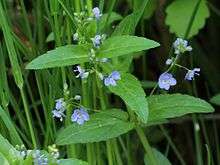Veronica americana
Veronica americana, variously called American brooklime[1] or American speedwell,[1][2] is a plant native to temperate and arctic Asia and North America[1] where it grows in streams and bottomlands.
| Veronica americana | |
|---|---|
 | |
| Scientific classification | |
| Kingdom: | Plantae |
| Clade: | Tracheophytes |
| Clade: | Angiosperms |
| Clade: | Eudicots |
| Clade: | Asterids |
| Order: | Lamiales |
| Family: | Plantaginaceae |
| Genus: | Veronica |
| Species: | V. americana |
| Binomial name | |
| Veronica americana | |
It is a herbaceous perennial with glabrous stems 10–100 cm long that bear terminal or axillary racemes or spikes of soft violet flowers. The leaves are 1.5–8 cm long and 3 to 20 times as long as wide, short-petiolate, glabrous, serrate to almost entire.[3]
The plant can be confused with Scutellaria (skullcap) and other members of the mint family. Members of the mint family have square sided stems, and Veronica species have rounded stems.[4]
Uses
American speedwell is used both as food and as a medicinal plant. It is rich in nutrients and is reported to have a flavor similar to that of watercress.[5]
References
- "Veronica americana". Germplasm Resources Information Network (GRIN). Agricultural Research Service (ARS), United States Department of Agriculture (USDA). Retrieved 2008-03-30.
- "Veronica americana Schwein. ex Benth". PLANTS Profile. United States Department of Agriculture; Natural Resources Conservation Service. Retrieved 2008-03-30.
- "Veronica americana". WTU Herbarium Image Collection. Burke Museum, University of Washington. Retrieved 2008-03-30.
- Edible and Medicinal Plants of the West, Gregory L. Tilford, ISBN 0-87842-359-1
- Reiner, Ralph E. (1969). Introducing the Flowering Beauty of Glacier National Park and the Majestic High Rockies. Glacier Park, Inc. p. 96.
| Wikimedia Commons has media related to Veronica americana. |
Further reading
- Moreno-Escobar, Jorge; Alvarez, Laura; Rodriguez-Lopez, Veronica; Marquina Bahena, Silvia (2013). "Cytotoxic glucosydic iridoids from Veronica americana". Phytochemistry Letters. 6 (4): 610–613. doi:10.1016/j.phytol.2013.07.017.